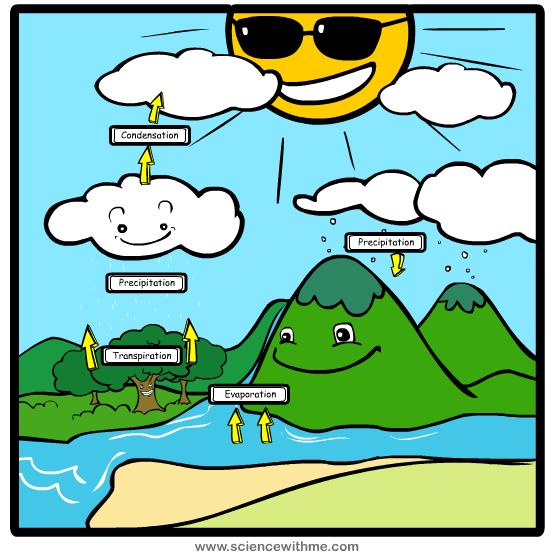The constant movement of water on, above and below the surface of the Earth is called the Water Cycle.
Next time you pour a glass of water take a look at the water. It is very possible the water in your glass fell as rain just last week.
The Earth has a finite or limited amount of water. All the same water on our beautiful planet has been going around and around since the beginning of time! It just keeps going around and around in different forms. Water can change state from liquid to vapor to ice at different places on the water cycle. However, the balance (or amount) of water always stays the same. So the water in your glass is very, very, very old indeed! (but it still tastes good). If you think of a person who lived hundreds of years ago, well the water in your glass was on the Earth then too! Maybe they even drank the same water as you…ewwwww!!
Don’t worry, all the water in your tap is very clean due to filtration.
The whole Water Cycle is driven by the sun.

What are the stages of the Water Cycle?
This continuous “movement” of water or “cycle” of water is made up of different stages.
Evaporation
Evaporation is when the sun heats up water in rivers or lakes and turns it into vapor or steam. The vapor or steam then leaves the river, lake or ocean and goes up into the air. Transpiration is basically the same process but in plants. Transpiration is the process by which plants lose water out of their leaves. Perspiration (sweating) is how humans lose water out of their bodies. So that glass of water you gulped down after playing football will eventually end up back in the air!
Condensation
But how does this vapor or steam get changed back in to liquid again? This is where condensation comes into the equation. When vapor in the air gets cold it changes back into liquid, forming clouds. This is called condensation. So that glass of water you drank will sweat out of you and when it hits the cold air it will turn to water up in the clouds…pretty cool right? Another example of condensation would be when steam or vapor from cooking something hits a cold glass window pane, you’ll sometimes see the condensation dripping down the window in the form of liquid. Next time you see something cooking look at the window pane of your kitchen window.
Precipitation
Precipitation occurs when so much water has condensed that the air cannot hold it anymore. The clouds in the sky look really heavy like they are bursting with water. This is how the water falls back to Earth in the form of rain, hail, sleet or snow.
Collection
When the water falls back to Earth it gets collected in rivers, lakes or the seas. When it hits dry land it gets soaked into the ground and plants or animals will drink it and the whole process (water cycle) starts again.
How is tap water cleaned?
It is not always possible for humans to drink the water collected directly as it may be dirty. So it is necessary for a cleaning process to occur before it is sent into our taps.
When water falls back down to earth it is called raw water. After this occurs, some of the water is collected into dams where there is a purification station. Here the water is screened for dirt and bacteria because if you drank this raw water you would get sick. In the purification station the water is sent through a filter to trap the germs and then chlorine gas is bubbled through the water. This process is called chlorination. So by the time the water reaches your tap it is very, very clean. Over 36,000 dams have been built in the world to collect and clean the water that falls back down to the Earth.
Another simpler way to clean raw water is to boil it, allow it to cool and keep it covered. This process is called distillation.
Interesting Facts about water
- Water is the only substance on earth which comes in three different forms; liquid, solid and a gas
- Our blood is 83% water, the wettest part of our body.
- Human beings can only live for 10 days at the longest without water, for our bodies are 65% water. In other words water and the water cycle is more precious than gold!
Guess what? We’ve got a free worksheet and coloring page about the water cycle to help you practice what we just learned!
